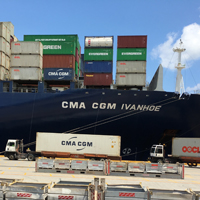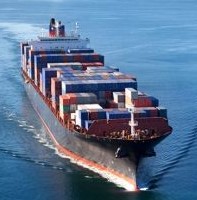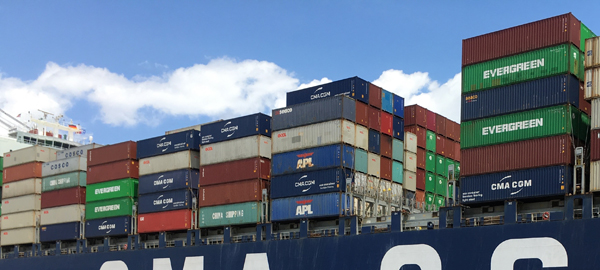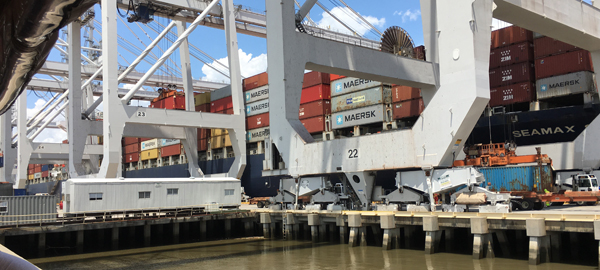
FTZ’ine June 2024
June 5, 2024
FTZ’ine August 2024
July 31, 2024Where Will You Be Tonight At 9?
Our guess is that you will be watching the historic showdown between current President Joseph Biden and former President Donald Trump. The City of Atlanta hosts as CNN’s Jake Tapper and Dana Bash will moderate this year’s first Presidential debate beginning at 9 pm eastern.
Trade, particularly trade with China, will be a key topic to follow tonight for the FTZ community. Although the election is months away, popular ideas that come out of the exchange could be implemented sooner.
Immigration will be another hot topic to watch for. Arrests for illegal border crossings have dropped more than 40% since the Biden administration suspended asylum processing, according to the Department of Homeland Security. Changes in immigration policy can have a direct impact on the trade community because it affects CBP personnel allocations.
In other trade news, ocean rates continue to rise right before peak season begins. Improving operations at the Port of Baltimore and the Panama Canal are not offsetting disruption in Red Sea routes.
The FTZ’ine staff wishes all our readers a safe and joyous 4th of July holiday break. See you next month.
Top Story: Congestion Fuels Peak-Season Price Spike
Disruptions originating from the violence in the Red Sea are crimping container and vessel availability right before the peak shipping season begins in the U.S. Spot rates for ocean shippers are rising rapidly in response.
Container vessel backlogs are growing off the coasts of Singapore, Malaysia, South Korea and China in scenes reminiscent of the pandemic. Extended shipping and wait times mean containers don’t turn over as quickly, making importers and exporters scramble for empty boxes.
Just as trade volumes are pointing towards the busiest summer ever in the U.S., carriers appear to be managing capacity to bolster pricing and profitability, which could mean more price increases and surcharges in the coming months.
“From the Far East into the U.S. West Coast, it is likely spot rates will surpass the level seen at the height of the Red Sea crisis earlier this year, which demonstrates how dramatic the recent increases have been,” said Emily Stausbøll, senior shipping analyst at Xeneta.
Spot rates had fallen after the sharp rise triggered by Red Sea tensions in early 2024, but since the end of April they began spiking by as much as $1,500, on average, on routes to the U.S. coasts, and now some of the highest contract rates charged by shippers are over double the rates of just a month ago.


Tech Tip: CBP Set To Begin Validating In-Bond FIRMS Codes
Later this summer on August 10, 2024, U.S. Customs and Border Protection (CBP) will deploy enhancements to ACE to validate the Facilities Information and Resource Management System (FIRMS) code on in-bond arrivals. This deployment excludes arrivals by air. This enhancement will, for non-air modes of transportation, enforce existing requirements that filers provide a valid FIRMS code when arriving an in-bond.
So while data requirements are not changing, if you have not been filing accurate FIRMS Codes, your in-bond arrivals may start bouncing. In-bonds must be properly arrived before the time limit expires to avoid the possibility of a liquidated damages assessment from CBP.
Questions related to the new In-Bond arrival requirements from CBP? Contact us at info@iscm.co.
Biden Administration Reinstates Solar Tariffs
Special tariffs to protect America’s solar industry from foreign competition have just been reinstated, ending a two-year pause on certain anti-dumping (AD) duties that President Biden postponed as part of his effort to jump-start solar panel installation in the U.S.
The new tariffs will apply to certain solar products made by Chinese companies but coming to the United States through Cambodia, Thailand, Malaysia and Vietnam.
The additional tariffs were actually approved two years ago after U.S. Department of Commerce (DOC) officials ruled that some Chinese firms were trying to dodge Section 201 & 301 tariffs by routing Chinese solar panels through other countries. The DOC investigated eight companies and concluded that five were violating the U.S. laws.
The exact AD tariff rate depends on the company, but could be more than 250 percent.
The Chinese firms had set up factories in Southeast Asia, but Commerce Department officials said that some were not doing substantial manufacturing there. Rather, they were using sites in those countries to make minor changes to Chinese-made solar products, and then shipping them to the United States tariff-free, the ruling decided.
Those products should have been subject to additional tariffs, but the Biden administration made an unusual decision in June 2022 to temporarily pause them for two years, to ensure that the United States would still have access to plenty of solar panels. The AD duties add to a complicated web of additional Section 201 and Section 301 additional duties that also apply to solar panels from China.
In the two years since the Biden administration made the decision to pause the tariffs, solar prices have cratered, and solar panel imports have surged.
By some estimates there are nearly two year’s worth of subsidized, imported solar panels sitting in U.S. warehouses that were brought in while the tariffs were suspended. That will create a pricing headache for domestic manufacturers for years.
In March, Treasury Secretary Janet L. Yellen delivered a speech in Norcross, Ga., at Suniva, a struggling solar manufacturer that has received subsidies through the 2022 Inflation Reduction Act. Ms. Yellen noted that the company, which filed for bankruptcy in 2017, is now restarting production of solar cells this year.
However, she also suggested that such investments could be threatened by China’s excess industrial capacity of green energy technology. “China’s overcapacity distorts global prices and production patterns and hurts American firms and workers, as well as firms and workers around the world,” she said.
China accounts for more than 80 percent of global solar supply at every stage of the production chain, from the raw material of polysilicon to the final panels.


China Exports Growing Again - Raising Global Trade Tensions
The value of China’s exports climbed 7.6 percent compared with May 2023, the quickest pace in more than a year. Prices of manufactured goods such as appliances, cars and electronics fell, exacerbating global concerns about fair trade with China.
China is rapidly building new factories and expanding existing ones as part of its national economic strategy. But domestic spending is weak in China, because of an extended slide in real estate prices.
That means much of the extra factory output needs to be exported. With fewer Chinese families buying new apartments, fewer household appliances are sold domestically, for example. The government said that the value of exports of appliances climbed 18.3 percent in May compared with a year ago. And because demand is so weak in China, appliance prices have tumbled. The actual number of appliances exported last month rose 27.8 percent.
The value of China’s imports rose only 1.8 percent in May.
China’s trade surplus, the difference between what it earns selling goods to the world and what it spends on imports, expanded in May to $82.6 billion. That was up 25.6 percent from a year earlier. It was the largest ever for May and one of the highest months ever except during the pandemic, when China exported huge quantities of medical gear, exercise equipment and other manufactured goods.
China’s trade surplus has tended to be fairly low in May and much higher later in the year, when its exporters supply goods for the Christmas season.
The quantity of many exports, not just household appliances, has been rising faster than their value. So many containers full of goods are leaving China, as fewer come back with imports, that shipping lines have been running short of containers in China.
Baltimore, Panama Operations Improvements Fail To Offset Red Sea Shipping Woes
The Port of Baltimore is restoring normal operations, and now cruise line calls have recently returned. That is a relief, especially for bulk and RoRo shippers for whom Baltimore is an important east-coast gateway.
Rain has returned to Panama, filling Lake Gatun and allowing increased transits through the Panama Canal.
Those improvements have not been enough to stabilize container freight shipping costs and delays. Problems in the Red Sea are adding up to two weeks of transit times to routes that normally used the Suez Canal. That two weeks of lost container and vessel capacity are causing delays at major international shipping hubs, including the world's largestSingapore.
The Dali sailed to Norfolk, Virginia with the assistance of four tugboats, removing one of the last reminders of the Francis Scott Key Bridge collapse. Approximately 50,000 tons of wreckage have also been removed to allow the Port of Baltimore to reopen completely.
The National Transportation Safety Board (NTSB), FBI and US Coast Guard are still investigating the crash, and costs for reconstructing the bridge by 2028 are expected to reach $1.9 billion.
Despite this improvement in ocean shipping reliability, Houthi rebels in Yemen are still firing on ships entering the Red Sea en route to the Suez Canal. In recent weeks, such assaults have sunk two vessels, including a Greek-owned ship carrying coal.
With container traffic through the Suez Canal dropping to one-tenth of its usual flow, most ships moving between Asia and Europe now circumnavigate Africa, which entails burning more fuel during the 11-14 days required for the extra travel.
At the same time, carriers have concentrated their fleets on the most lucrative routes, those connecting destinations like Shanghai and the Dutch port of Rotterdam, Europe’s busiest. That has forced cargo bound for other places to stop for loading and reloading at major hubs known as transshipment ports.
The largest such ports, including Singapore and the Sri Lankan capital, Colombo, are now overwhelmed with incoming vessels. Ships must wait at anchor for as long as a week before pulling up to the docks.
Adding to shipping uncertainty is an ILA dockworker threat to strike on the East and Gulf Coasts of the United States, while longshore workers at German ports have already halted shifts. Rail workers in Canada are poised to walk off the job, creating backups at Vancouver and British Columbia.
The intensifying upheaval in shipping is prompting carriers to lift rates while raising the specter of waterborne gridlock that could again threaten retailers with product shortages during the make-or-break holiday shopping season. The disruption could also exacerbate inflation, a source of economic anxiety animating the American presidential election.
Since October, the cost of moving a 40-foot shipping container from China to Europe has increased to about $7,000, from an average of roughly $1,200, according to data compiled by Xeneta, a cargo analytics company based in Norway. That is well below the $15,000 peak reached in late 2021, when supply chain disruptions were at their worst, but it is about five times the prices that prevailed for the years leading up to the pandemic.
Rates to ship goods across the Pacific have multiplied by a similar magnitude. It now costs over $6,700 to transport a 40-foot container from Shanghai to Los Angeles, and nearly $8,000 for Shanghai to New York. As recently as December, those costs were near $2,000.
“We haven’t seen the peak yet,” said Peter Sand, Xeneta’s chief analyst.
Three primary alliances of carriers control 95 percent of the container traffic between Asia and Europe and more than 90 percent between Asia and the East Coast of the United States, according to the International Transport Forum, an intergovernmental organization in Paris with 69 member countries including China and the United States.


FTZ Staff Activity
- FTZ Board Staff processed a processed a Minor Boundary Modification (S-94-2024) in FTZ 153K on behalf of USMCA Cargo Connect dba USMCA FTZ, San Diego, CA on June 6, 2024
- FTZ Board Staff processed a Traditional Site Framework Subzone Application (S-95-2024) in FTZ 250 on behalf of Boss Laser, LLC, Sanford, FL in June, 2024
- FTZ Board Staff processed a Minor Boundary Modification (S-96-2024) in FTZ 22 on behalf of DSV Air and Sea, Inc., Bensenville, IL on June 11, 2024
- FTZ Board Staff processed a Minor Boundary Modification (S-97-2024) in FTZ 241 on behalf of US Marina Group LLC DBA 17th Street Yacht Basin, Ft. Lauderdale, FL on June 11, 2024
- FTZ Board Staff processed a Minor Boundary Modification (S-98-2024) in FTZ 75V on behalf of LG Energy Solution Arizona, Inc., Queen Creek, AZ on June 12, 2024
Foreign-Trade Zone Board Activity
-
- Hardware Plus, Inc. received approval to operate its Caguas, Puerto Rico facilities as Subzone 7T. MORE
- SNRA Commodities, Inc. submitted a notification of proposed production activity for pecans within Foreign-Trade Zone 68 in Fabens, Texas. MORE
- Vitesco Technologies USA, LLC received approval to operate its Seguin, Texas facilities as Subzone 80G. MORE
- Hamilton Beach Brands, Inc received approval to operate its Byhalia, Mississippi facilities as Subzone 262F. MORE
- Valbruna Slater Stainless Inc. received authorization of production activity for metal ingots within Foreign-Trade Zone 182A in Fort Wayne, Indiana. MORE
- AbbVie, Inc. submitted a notification of proposed production activity for pharmaceutical products within Foreign-Trade Zone 22S in North Chicago, Illinois. MORE
- Sediver USA, Inc. received approval to operate its West Memphis, Arkansas facilities as Subzone 273B. MORE
- Patheon Softgels submitted a notification of proposed production activity for pharmaceutical products within Foreign-Trade Zone 230 in High Point, North Carolina. MORE
- Intel Corporation submitted an application to expand Subzone 75C to include a new site (#6) in Phoenix, Arizona. MORE
- Catalent Pharma Solutions, LLC submitted a notification of proposed production activity for nonsteroidal antiandrogen tablets within Foreign-Trade Zone 29 in Winchester, Kentucky. MORE

Where Will You Be Tonight At 9?:
Our guess is that you will be watching the historic showdown between current President Joseph Biden and former President Donald Trump. The City of Atlanta hosts as CNN’s Jake Tapper and Dana Bash will moderate this year’s first Presidential debate beginning at 9 pm eastern.
Trade, particularly trade with China, will be a key topic to follow tonight for the FTZ community. Although the election is months away, popular ideas that come out of the exchange could be implemented sooner.
Immigration will be another hot topic to watch for. Arrests for illegal border crossings have dropped more than 40% since the Biden administration suspended asylum processing, according to the Department of Homeland Security. Changes in immigration policy can have a direct impact on the trade community because it affects CBP personnel allocations.
In other trade news, ocean rates continue to rise right before peak season begins. Improving operations at the Port of Baltimore and the Panama Canal are not offsetting disruption in Red Sea routes.
The FTZ’ine staff wishes all our readers a safe and joyous 4th of July holiday break. See you next month.

